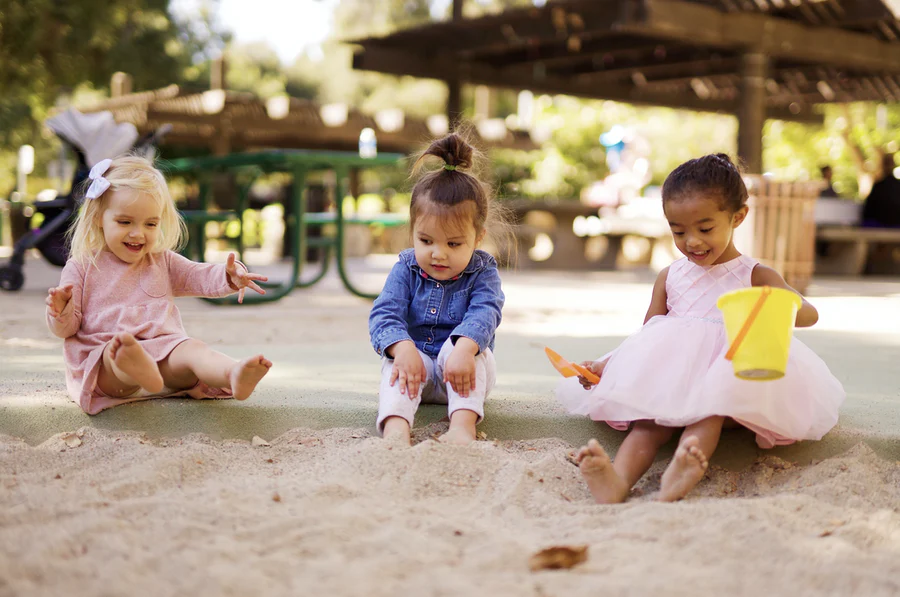Childhood experts believe that playful children lead much healthier lives than serious children. Dr. Peter Gray has even pointed out that lack of free play can lead to a severe decline in creativity and empathy. It can deprive your child of a positive and emotionally rich life.
So, see if your child engages in the 5 kinds of early childhood play listed below. If not, it’s time you take the necessary measures to encourage them to play.
-
Infant Play
Infant play is the first stage of play that lasts from birth until three months. During this stage, the child observes and understands their surroundings. This kind of play is instinctive. It involves looking around, learning to move, and interacting with the surroundings. Children also learn to use their senses via infant play.
It may not appear as play to you since you’ll only see your infant throwing hands in the air, wiggling feet, and cooing now and then. Experts suggest that you should not disturb your child as they engage in infant play. However, you can support their learning and play by putting on soothing music, reading to them, or providing textured or rattle toys.
-
Independent Play
Independent play follows infant play. It begins at the age of 2-3 years, and it’s also known as solitary play. It’s the stage where your child hasn’t developed a command over their social skills, so they play by themselves. Consequently, they learn how to keep themselves entertained and be self-sufficient.
So, it’s a good idea to introduce playing with loose parts at this stage. It will assist independent play and enhance your child’s inventive thinking and problem-solving skills.
Note that independent play usually lasts from 2 to 4 years of age. However, shy kids may adopt it as a lifestyle.
Although this isn’t something negative, it could rob your child of healthy social experiences. So, it’s a good idea to encourage them to engage in associative and cooperative play beyond the age of eight.
-
Observant Play
Observant play is also known as onlooker play. Your child will watch other children play, but they won’t participate. Instead, they’ll watch others intently and may comment now and then.
Your child should begin engaging in observant play at the age of two, and it should last up to 3.5 years. However, do not stress yourself if you see your child engage in onlooker play later in life. That’s because this play helps them develop cognitive skills by improving memory and perception.
It also assists the development of social-emotional skills as they learn to listen and acquire lessons from others’ experiences.
If you do not see your child engaging in observant play, it’s time to take action. Take your child to different playgrounds where they can watch other children play games. You can also take your child to sports events, concerts, and museums where they can observe and learn from the people around them.
-
Parallel Play
Children begin engaging in parallel play after three years of age, where they play side by side with other children in the room but don’t interact with them. It may appear as if children are not paying attention to one another. But in reality, they’re silently observing and mimicking each other.
The benefits of parallel play include:
-
Language development: During parallel play, your child will pick new words from nearby children. It will expand their vocabulary and introduce them to new ideas.
-
Understanding social interactions: When your child plays on their own in a group of children, they’re also observing how other children interact and play. It provides them room to learn about social interactions.
-
Learning to share: Parallel play often involves sharing toys. When one child needs a character in their little world, they may pick up a toy from the kid sitting across. The other kid might do the same. Although this act of sharing may occur without any verbal exchange, it develops a subconscious acceptance towards sharing.
If you don’t see your child engaging in parallel play, you can encourage them by demonstrating it to them. For example, you can try playing with legos in front of them and see if they join you. If they don’t, challenge your child to try a difficult lego figure.
Alternatively, play games with your little one where you take turns. Eventually, extend the duration of their turns such that they don’t expect you to take your turn anymore.
-
Associative Play
Associative play is the last type of individual play in early childhood. It begins at the age of four or five, and is a combination of cooperative play and parallel play. In some cases, associative play may start at as early as two.
In any case, this is the kind of play where children play alongside one another but interact minimally with each other. Their efforts are not coordinated or dependent on each other. For example, children might ride their tricycles together. But they don’t have a plan about where they’re going.
Similarly, children may be painting with the same materials, but they may not discuss and agree about what they should paint. They may paint on the same canvas, talk in between, but paint individually. It teaches young ones to cooperate and prepares them to actively play in groups once they’re older.
You may also like
-
Get FREE Admission to Amazone Playzone on Tuesday Morning
-
Three Month family Multi Park Passes at West Edmonton Mall are 50% off Until August 31st
-
Where and When to Get Half off Happy Hour Deals at Edmonton Indoor Playgrounds
-
Fun (and Free) Drop in Playgroups for Little Kids | February 2018
-
Fun (and Free) Drop in Playgroups for Little Kids in November | 2017
